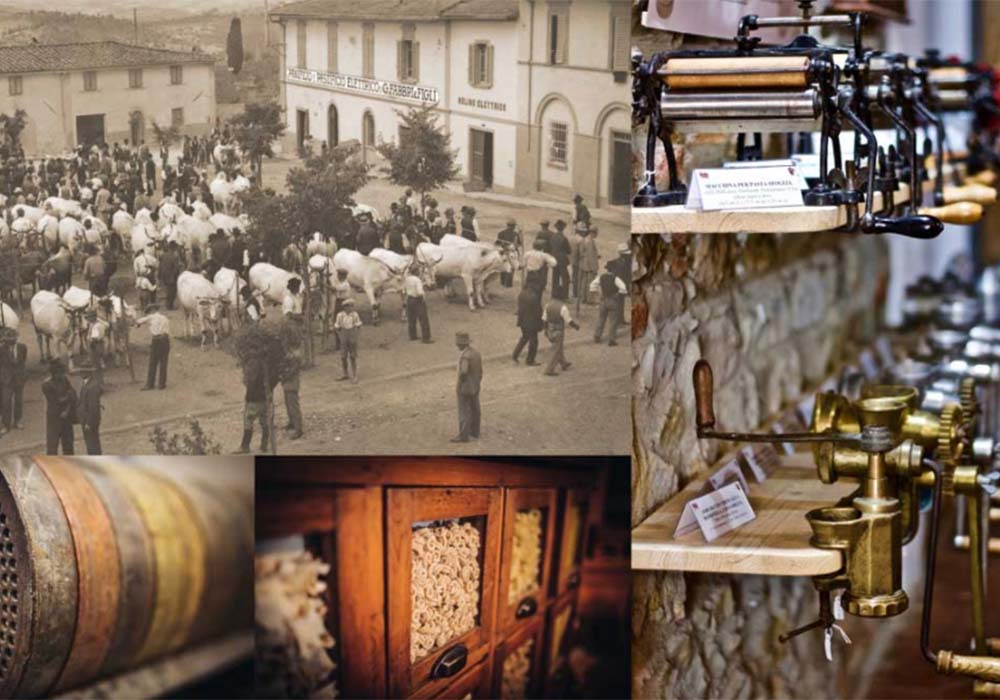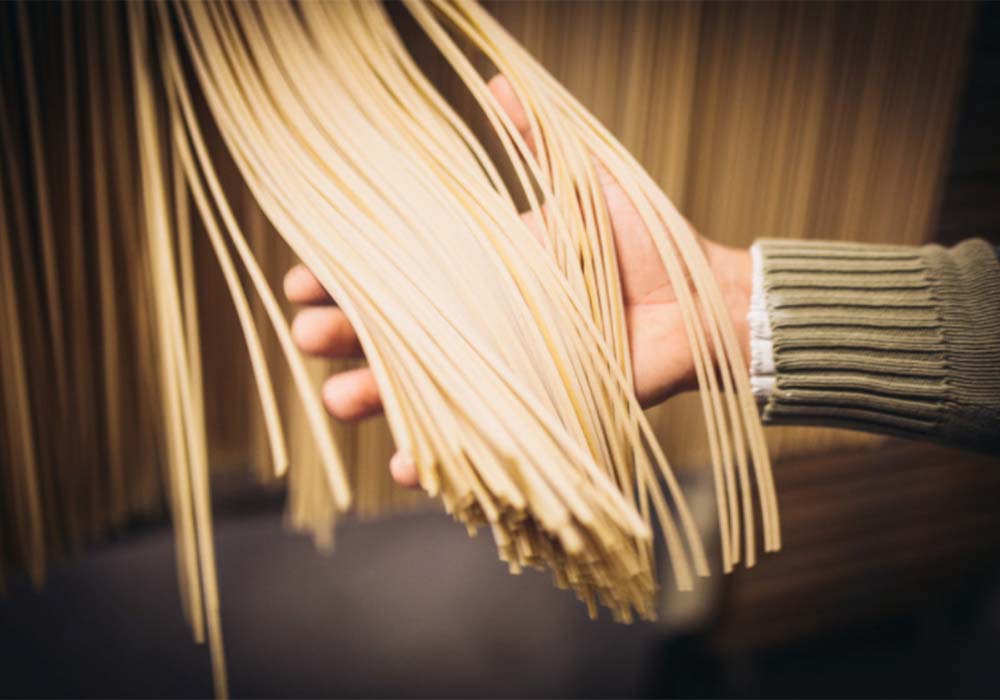
Pasta Fabbri. Would you like to know another Tuscan excellence? Get on board!
In this virtual journey in the Pasta Fabbri world, the starting point is Florence, the cradle of the Renaissance, and after taking the Chianti road heading south in just under half an hour, you will reach your destination.
We have arrived at the Pastificio Fabbri. Here the history of pasta production becomes a tradition. Since 1893, pasta has been processed in the same way without changes, from father to son in a straight line in Piazza Emilio Landi in Strada in Chianti.
In the Pastificio Artigiano Fabbri, for five generations, the old criteria for processing pasta have been respected in every phase, using the best ingredients and semolina from carefully selected grains, ground by trusted mills, and in every production process, using low temperatures. At the end of the production cycle, the pasta dries slowly (from 3 to 6 days depending on the format) to maintain unaltered organoleptic properties. In this process, the use of bronze dies and original machinery from the 1950s becomes fundamental.
The excellence of the raw materials combined with a long experience of 125 years guarantees a very high-quality and genuine pasta. Pastificio Fabbri uses 100% Italian grain, choosing it according to the nutritional properties, quantity, and quality of the gluten contained. Furthermore, the grain is grounded by high-quality mills that never have to heat the grain at any time in the process to maintain the organoleptic properties, as we said.
Even today, the continuous press "Cantini," bought by his grandfather Renzo in 1958, remains the heart of the production: this machine is capable of performing the essential operations of the manufacturing process, which are kneading and drawing, and allows to produce all shapes, both for short and long pasta. Fabbri obtains a rough and porous pasta with the bronze drawing that absorbs 30% more seasonings than a smooth pasta.
The pasta factory has hundreds of bronze dies that allow you to create many formats depending on the cut and the thickness set on the press. Among these molds, still used today to produce our pasta, some are authentic museum pieces such as the 1911 Reginelle format die or the Dischi Volanti (Flying saucer) die bought a few months after the UFO sighting in Florence on 27 October 1954.
As recommended by sector scientists, in order not to damage the gluten and avoid altering the nutritional properties of the wheat grain, low temperatures are always used, which in the Fabbri pasta factory never exceed 38°.
The kneading, the first stage of processing, occurs in a tank with semolina and cold water at a temperature kept strictly below 35° C. Then the pasta, as soon as it comes out of the die, is pre-dried at a temperature of about 33-35° C and will be placed in the drying cells from 3 days for short shapes up to 6 days for specific long pasta shapes.

Taking a small step back, let us tell the story of this company briefly.
The Fabbri history began in 1893 when the great-grandfather Giovanni. He moved from Cintoia to Strada in Chianti, a few kilometers closer to Florence, bringing the ancient knowledge of his parents, farmers, millers, and pasta makers. The Fabbri factory will pass on their expertise and production secrets for five generations from father to son.
Alongside the pasta maker business, each owner has carefully preserved the physical heritage handed down from his father until he built up a rich collection of various objects. Finally, Giovanni Fabbri, a proud representative of the fourth generation, decided to create a museum that today brings together more than 400 objects and a wide range of books and documents.
Giovanni Fabbri moves from Cintoia and acquires land in Piazza Landi (thanks to his wife's dowry). He sets up his pasta factory with an adjoining mill, laboratory, and food shop. At the beginning of the 1900s, the company was located at numbers 1-2-3-4 of the square. Even today, exactly as in 1893, the pasta factory frames the town square.
The Fabbri factory passes from the marble wheel with the horse to the electric pasta factory, then called "hygienic processing." On the death of Giovanni, his son Livio inherits the pasta factory while his other son Lionello recovers the laboratory and the store. At the end of the war, the furnace, the mill, and machinery are mined, and a part of the ceiling collapses: only the walls remain standing. The Fabbri family repairs the damage of the war and starts again, with the usual machines, at no. 6-7 of the same square.
Renzo, at the helm of the company together with his father Livio, acquires the first "Cantini" press to launch the company's development. To this day, the improved model from 1958 continues to be the heart of our production. After that, the factory moves to its current location, at 18 in the square where the stables were once located. Today Giovanni's children, Lisa and Marco, are at the helm of the company together with their father, as has been the family tradition for 125 years.

Raw materials and slow drying: 3 to 6 days
Pasta is obtained by drawing and drying doughs made of durum wheat flour. The company uses 100% Italian grain selected by nutritional properties, quantity, and in particular, the quality of the gluten. The wheat is milled and made into pasta, following the supply chain characteristics that respect the old processing criteria in every aspect.
The last stage of the production cycle, drying, is a delicate phase in which part of the initial water content is progressively eliminated. Great care is taken not to let the outside of the product dry too quickly; otherwise, the water, to escape, would risk breaking the pasta.
The pasta is placed in drying cells for a period ranging from 3 to 6 days, depending on the different formats.

Garbuio method: drying as in the early 1900s
The temperatures and drying times have remained those of the early twentieth century with the advent of the thermo-mechanical dryer, which reduced drying times to 3-6 days depending on the format. Until then, pasta was still drying outdoors, and the average drying times in the summer were about eight days for pasta factories on the Neapolitan coast and more than a month for those in the North. The oldest drying cell in the company, the "Garbuio," dated back to 1956 and was designed following the standards of the first thermo-mechanical dryers. Based on the original design, the other four drying cells were then built.
Garbuio Method, based on two fans inside the cell that direct the airflow to the right for about 30 minutes and then reverse the flow to the left for another 30 minutes. The water is slowly extracted from the pasta at a temperature below 38° C without risking damaging its integrity and its organoleptic qualities.
In the second post-war period, the average drying times are progressively shortened until today, and industrial pasta factories can dry pasta in a few hours using temperatures above 100° C.
According to the Maillard reaction, any protein subjected to temperatures above 38 ° C is transformed and undergoes thermal damage. The result of drying at low or high temperature is immediately visible from the color: the higher the temperatures, the more the pasta goes from a natural straw yellow to a burnt yellow, and it loses its ability to absorb the sauce because the gluten (composed of proteins) is denatured. Thus, the pasta is practically "toasted" and dehydrated.
The Fabbri drying method, below 38° C, allows instead to keep the protein structure unaltered. As a result, it results in a higher absorption capacity of the pasta, a much higher digestibility, and a creamy white color, precisely like gluten in its natural state.
It is precisely this drying method that gives a unique character: "a living pasta that smells of wheat," Giovanni Fabbri often says.

So what are you waiting for? One-click and Fabbri pasta will be on your table!
Click here and discover our selection
Join us on Instagram
We have arrived at the Pastificio Fabbri. Here the history of pasta production becomes a tradition. Since 1893, pasta has been processed in the same way without changes, from father to son in a straight line in Piazza Emilio Landi in Strada in Chianti.
In the Pastificio Artigiano Fabbri, for five generations, the old criteria for processing pasta have been respected in every phase, using the best ingredients and semolina from carefully selected grains, ground by trusted mills, and in every production process, using low temperatures. At the end of the production cycle, the pasta dries slowly (from 3 to 6 days depending on the format) to maintain unaltered organoleptic properties. In this process, the use of bronze dies and original machinery from the 1950s becomes fundamental.
The excellence of the raw materials combined with a long experience of 125 years guarantees a very high-quality and genuine pasta. Pastificio Fabbri uses 100% Italian grain, choosing it according to the nutritional properties, quantity, and quality of the gluten contained. Furthermore, the grain is grounded by high-quality mills that never have to heat the grain at any time in the process to maintain the organoleptic properties, as we said.
Even today, the continuous press "Cantini," bought by his grandfather Renzo in 1958, remains the heart of the production: this machine is capable of performing the essential operations of the manufacturing process, which are kneading and drawing, and allows to produce all shapes, both for short and long pasta. Fabbri obtains a rough and porous pasta with the bronze drawing that absorbs 30% more seasonings than a smooth pasta.
The pasta factory has hundreds of bronze dies that allow you to create many formats depending on the cut and the thickness set on the press. Among these molds, still used today to produce our pasta, some are authentic museum pieces such as the 1911 Reginelle format die or the Dischi Volanti (Flying saucer) die bought a few months after the UFO sighting in Florence on 27 October 1954.
As recommended by sector scientists, in order not to damage the gluten and avoid altering the nutritional properties of the wheat grain, low temperatures are always used, which in the Fabbri pasta factory never exceed 38°.
The kneading, the first stage of processing, occurs in a tank with semolina and cold water at a temperature kept strictly below 35° C. Then the pasta, as soon as it comes out of the die, is pre-dried at a temperature of about 33-35° C and will be placed in the drying cells from 3 days for short shapes up to 6 days for specific long pasta shapes.

Taking a small step back, let us tell the story of this company briefly.
The Fabbri history began in 1893 when the great-grandfather Giovanni. He moved from Cintoia to Strada in Chianti, a few kilometers closer to Florence, bringing the ancient knowledge of his parents, farmers, millers, and pasta makers. The Fabbri factory will pass on their expertise and production secrets for five generations from father to son.
Alongside the pasta maker business, each owner has carefully preserved the physical heritage handed down from his father until he built up a rich collection of various objects. Finally, Giovanni Fabbri, a proud representative of the fourth generation, decided to create a museum that today brings together more than 400 objects and a wide range of books and documents.
Giovanni Fabbri moves from Cintoia and acquires land in Piazza Landi (thanks to his wife's dowry). He sets up his pasta factory with an adjoining mill, laboratory, and food shop. At the beginning of the 1900s, the company was located at numbers 1-2-3-4 of the square. Even today, exactly as in 1893, the pasta factory frames the town square.
The Fabbri factory passes from the marble wheel with the horse to the electric pasta factory, then called "hygienic processing." On the death of Giovanni, his son Livio inherits the pasta factory while his other son Lionello recovers the laboratory and the store. At the end of the war, the furnace, the mill, and machinery are mined, and a part of the ceiling collapses: only the walls remain standing. The Fabbri family repairs the damage of the war and starts again, with the usual machines, at no. 6-7 of the same square.
Renzo, at the helm of the company together with his father Livio, acquires the first "Cantini" press to launch the company's development. To this day, the improved model from 1958 continues to be the heart of our production. After that, the factory moves to its current location, at 18 in the square where the stables were once located. Today Giovanni's children, Lisa and Marco, are at the helm of the company together with their father, as has been the family tradition for 125 years.

Raw materials and slow drying: 3 to 6 days
Pasta is obtained by drawing and drying doughs made of durum wheat flour. The company uses 100% Italian grain selected by nutritional properties, quantity, and in particular, the quality of the gluten. The wheat is milled and made into pasta, following the supply chain characteristics that respect the old processing criteria in every aspect.
The last stage of the production cycle, drying, is a delicate phase in which part of the initial water content is progressively eliminated. Great care is taken not to let the outside of the product dry too quickly; otherwise, the water, to escape, would risk breaking the pasta.
The pasta is placed in drying cells for a period ranging from 3 to 6 days, depending on the different formats.

Garbuio method: drying as in the early 1900s
The temperatures and drying times have remained those of the early twentieth century with the advent of the thermo-mechanical dryer, which reduced drying times to 3-6 days depending on the format. Until then, pasta was still drying outdoors, and the average drying times in the summer were about eight days for pasta factories on the Neapolitan coast and more than a month for those in the North. The oldest drying cell in the company, the "Garbuio," dated back to 1956 and was designed following the standards of the first thermo-mechanical dryers. Based on the original design, the other four drying cells were then built.
Garbuio Method, based on two fans inside the cell that direct the airflow to the right for about 30 minutes and then reverse the flow to the left for another 30 minutes. The water is slowly extracted from the pasta at a temperature below 38° C without risking damaging its integrity and its organoleptic qualities.
In the second post-war period, the average drying times are progressively shortened until today, and industrial pasta factories can dry pasta in a few hours using temperatures above 100° C.
According to the Maillard reaction, any protein subjected to temperatures above 38 ° C is transformed and undergoes thermal damage. The result of drying at low or high temperature is immediately visible from the color: the higher the temperatures, the more the pasta goes from a natural straw yellow to a burnt yellow, and it loses its ability to absorb the sauce because the gluten (composed of proteins) is denatured. Thus, the pasta is practically "toasted" and dehydrated.
The Fabbri drying method, below 38° C, allows instead to keep the protein structure unaltered. As a result, it results in a higher absorption capacity of the pasta, a much higher digestibility, and a creamy white color, precisely like gluten in its natural state.
It is precisely this drying method that gives a unique character: "a living pasta that smells of wheat," Giovanni Fabbri often says.

So what are you waiting for? One-click and Fabbri pasta will be on your table!
Click here and discover our selection
Join us on Instagram
Share on:
Powered & Designed by Passepartout


